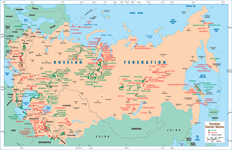FSU/ Eastern Europe: Azerbaijan
Aug. 2001 Vol. 222 No. 8 International Outlook FSU/EASTERN EUROPE Azerbaijan Last year was a period of slow but steady progress for the country’s E&P
FSU/EASTERN EUROPEAzerbaijanLast year was a period of slow but steady progress for the country’s E&P sector. A number of major oil companies entered the region, while several smaller players departed. In addition, as noted by Wood MacKenzie, there were some disappointments, including poor results from Agip’s first exploration well on the Kur Dashi Block and Ramco’s appraisal at the onshore Muradkhanli field. Nevertheless, the mega-development projects remain on track.
Exploration. Moncrief Oil gained the onshore Kamaleddin-Mishovdag contract area last year. LUKoil acquired the Govsany-Zykh contract area, while BP relinquished the disappointing Dan Ulduzu Block. Devon Energy increased its share of the Azeri Chirag Guneshli (ACG) concession being developed by BP-led Azerbaijan International Operating Co. (AIOC). Devon purchased 0.8% from Ramco Energy. New licensees included Conoco, which won a 20% outstanding interest in the Zafar Mashal deepwater block; Shell, which acquired 25% in Inam from CFC and Lasmo; and Sooner Petroleum, which gained a 12.75% share in the Southwest Gobustan Contract Area from Commonwealth. Exxon last September ran a three-month, 328-sq-mi, 3-D seismic survey over its Zafar-Mashal deepwater block, 68 mi southeast of Baku. In addition, Exxon’s Oguz Operating Co. subsidiary began drilling the Neft Dashlary East 1 wildcat offshore last April, 37 mi east of Baku. Exxon will also spud the first wildcat on its Nakhchivan tract in third-quarter 2001. Drilling should take 260 days to reach 21,140 ft. State firm Socar said in mid-June, that Guneshli 1 had confirmed more than 2 Bcm (70.6 Bcf) of gas in the shallow portion of Guneshli field, in the ACG concession. The well is part of a five-well program to prove gas reserves. Socar plans to construct a platform and drill eight more wells. Last December, Chevron spudded the first wildcat on its Absheron offshore block in 1,700 ft of water. Drilling was set to finish in July, after the well reached a 16,075-ft TD. BP also spudded the first wildcat on its Inam offshore block, in 450 ft of water. Drilling was halted in February at 14,574 ft, when unusually high formation pressures were encountered. The well contract had been due to finish, so work was halted until mid-summer, so that another rig could be obtained. Onshore, Ramco had hoped to prove additional commercial reserves at Muradkhanli field. However, the first appraisal well, the MOC1z sidetrack, to the MOC 1 wildcat, failed to prove commercial oil flows last March. Exploration has been constrained by a shortage of adequate offshore drilling rigs. However, with the new Gurtulush jack-up now operational, and upgrades completed on the Dada Gorgud and Istiglal semi-submersibles, activity should begin to rise. In addition, Exxon last February awarded a $250-million contract, to build a semi-submersible for use in the Caspian. Exploration failed to yield any major reserve additions last year. Wood MacKenzie still estimates undiscovered resources at 2 to 11 billion bbl of oil and 14 to 90 Tcf of gas. Drilling / development. Operators increased their drilling significantly last year. Wells drilled rose 33%, while footage drilled increased 34%, to 403,448. Offshore footage drilled jumped 20% higher, to 267,697. A 9% increase in drilling is forecast this year. During a presentation in May to Azerbaijani President Haydar Aliyev, BP Azerbaijan Associate President David Woodward said that his firm and its partners would spend more than $8 billion on developing the ACG and Shah Deniz fields. BP last May awarded a front-end engineering design contract for a drilling platform at Shah Deniz. As scheduled, drilling would begin in second-quarter 2004, with first production in third-quarter 2004. AIOC’s Chirag field Future Development project is underway, including an upgrade of the rig and separator vessels, and enlarging the booster pumps. Three wells will also be drilled, to boost ACG output to 130,000 bopd from 117,000 bopd. Production. Combined crude and condensate output gained 2%, to 278,298 bpd. Natural gas production declined 5%, to 608 MMcfd. BP reported that AIOC has begun utilizing Chirag’s gas output, sending the 95-MMcfg flow to the Oil Rocks station rather than flaring it at the platform. In an odd twist, at least 20 wells onshore and offshore that had been inactive for more than 10 years began producing natural gas again after a major earthquake (6.5 on the Richter scale) hit the area in late November. Socar said that pressure build-up in the wells after the earthquake had allowed more gas to be pumped into the pipeline system. Socar has been testing all old wells to determine the full impact. The ACG development should account for about 60% to 70% of Azerbaijan’s total production by 2010. The installation experienced an increase in liquids production of about 9,000 bpd between 1999 and 2000. During 2000, average ACG output was 104,000 bopd, or 37% of the national total. Future gas output has depended on expansion of the
Turkish gas market and the share of it that can be secured. A major step was taken last March, when the
Azerbaijani and Turkish presidents signed a deal, whereby Turkey will buy 70 Bcf of gas produced from Shah
Deniz in 2004. That amount would rise to 231 Bcf/year by 2007. |
- Applying ultra-deep LWD resistivity technology successfully in a SAGD operation (May 2019)
- Adoption of wireless intelligent completions advances (May 2019)
- Majors double down as takeaway crunch eases (April 2019)
- What’s new in well logging and formation evaluation (April 2019)
- Qualification of a 20,000-psi subsea BOP: A collaborative approach (February 2019)
- ConocoPhillips’ Greg Leveille sees rapid trajectory of technical advancement continuing (February 2019)



